- Photo Safaris
- Alaska Bears & Puffins World's best Alaskan Coastal Brown Bear photo experience. Small group size, idyllic location, deluxe lodging, and Puffins!
- Participant Guestbook & Testimonials Candid Feedback from our participants over the years from our photo safaris, tours and workshops. We don't think there is any better way to evaluate a possible trip or workshop than to find out what others thought.
- Custom Photo Tours, Safaris and Personal Instruction Over the years we've found that many of our clients & friends want to participate in one of our trips but the dates we've scheduled just don't work for them or they'd like a customized trip for their family or friends.
- Myanmar (Burma) Photo Tour Myanmar (Burma) Photo Tour December 2017 -- with Angkor Wat option
- Reviews Go hands-on
- Camera Reviews Hands-on with our favorite cameras
- Lens reviews Lenses tested
- Photo Accessories Reviews Reviews of useful Photo and Camera Accessories of interest to our readers
- Useful Tools & Gadgets Handy tools and gadgets we've found useful or essential in our work and want to share with you.
- What's In My Camera Bag The gear David Cardinal shoots with in the field and recommends, including bags and tools, and why
- Articles About photography
- Getting Started Some photography basics
- Travel photography lesson 1: Learning your camera Top skills you should learn before heading off on a trip
- Choosing a Colorspace Picking the right colorspace is essential for a proper workflow. We walk you through your options.
- Understanding Dynamic Range Understanding Dynamic Range
- Landscape Photography Tips from Yosemite Landscape Photography, It's All About Contrast
- Introduction to Shooting Raw Introduction to Raw Files and Raw Conversion by Dave Ryan
- Using Curves by Mike Russell Using Curves
- Copyright Registration Made Easy Copyright Registration Made Easy
- Guide to Image Resizing A Photographers' Guide to Image Resizing
- CCD Cleaning by Moose Peterson CCD Cleaning by Moose Peterson
- Profiling Your Printer Profiling Your Printer
- White Balance by Moose Peterson White Balance -- Are You RGB Savvy by Moose Peterson
- Photo Tips and Techniques Quick tips and pro tricks and techniques to rapidly improve your photography
- News Photo industry and related news and reviews from around the Internet, including from dpreview and CNET
- Getting Started Some photography basics
- Resources On the web
- My Camera Bag--What I Shoot With and Why The photo gear, travel equipment, clothing, bags and accessories that I shoot with and use and why.
- Datacolor Experts Blog Color gurus, including our own David Cardinal
- Amazon Affiliate Purchases made through this link help support our site and cost you absolutely nothing. Give it a try!
- Forums User to user
- Think Tank Photo Bags Intelligently designed photo bags that I love & rely on!
- Rent Lenses & Cameras Borrowlenses does a great job of providing timely services at a great price.
- Travel Insurance With the high cost of trips and possibility of medical issues abroad trip insurance is a must for peace of mind for overseas trips in particular.
- Moose Peterson's Site There isn't much that Moose doesn't know about nature and wildlife photography. You can't learn from anyone better.
- Journeys Unforgettable Africa Journeys Unforgettable -- Awesome African safari organizers. Let them know we sent you!
- Agoda International discounted hotel booking through Agoda
- Cardinal Photo Products on Zazzle A fun selection of great gift products made from a few of our favorite images.
- David Tobie's Gallery Innovative & creative art from the guy who knows more about color than nearly anyone else
- Galleries Our favorite images
The Great Migration: Anatomy of a Crossing
The Great Migration: Anatomy of a Crossing
Submitted by David Cardinal on Tue, 10/14/2014 - 11:35
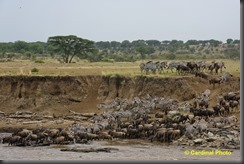 No matter how often you’ve watched it on video, or seen those amazing images of Wildebeest herds crashing down the bank of the Mara River, nothing is quite like the experience of watching it in person. Our group was fortunate enough to witness (and photograph) several crossings on our recent trip. Each one was different, of course, but there is much about crossings that isn’t obvious from the photos, and isn’t featured in most video documentaries that’s worth passing along…
No matter how often you’ve watched it on video, or seen those amazing images of Wildebeest herds crashing down the bank of the Mara River, nothing is quite like the experience of watching it in person. Our group was fortunate enough to witness (and photograph) several crossings on our recent trip. Each one was different, of course, but there is much about crossings that isn’t obvious from the photos, and isn’t featured in most video documentaries that’s worth passing along…
Wildebeest crossings don’t have a schedule
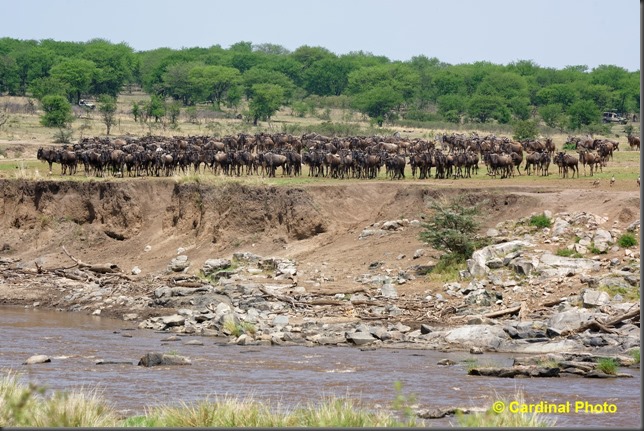
Nikon D810, Sigma 120-300mm f/2.8 Lens @ 210mm. f/9.5 @ 1/1500s, ISO 800
Image processed with DxO Optics Pro
There is definitely a peak season for the most dramatic migration – across the Mara River, which runs roughly between the Serengeti in Tanzania and the Mara in Kenya. In a typical year that might be from around July to September going North, and not long after that, returning south. However, this year the migration was at least three weeks early, so during our visit in late September all the crossings and near-crossings we witnessed were from North (where the Wildebeest and Zebra go after the Serengeti Plains dry out) to the South (where they return after the rains start).
The overall migration is a much larger cycle, involving the vast expanse of the Southern Serengeti and the more varied terrain of the Western Serengeti, but those areas don’t feature the steep-banked Mara River which makes for the dramatic crossings.
Mara River crossings go both ways
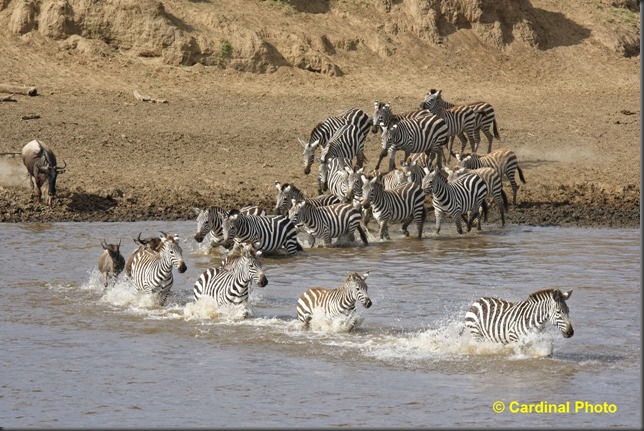
Nikon D810, Sigma 120-300mm f/2.8 Lens w. 1.4 TC @ 350mm. f/16 @ 1/500s, ISO 800
Image processed with DxO Optics Pro
Unlike the bird and bat migrations most of us think of when we hear the term migration, the Wildebeest and Zebra migration is much more opportunistic. The animals can cross and re-cross the Mara River, for example, 10 or even 20 times in a single season. They are drawn by the smell of rain, so if they smell better grazing on the other side of the River after a rainstorm, they may well cross. A change in rain patterns and they may cross back. Ultimately most of them do wind up continuing onward, away from the River, but some stay near there each year.
Patience is essential
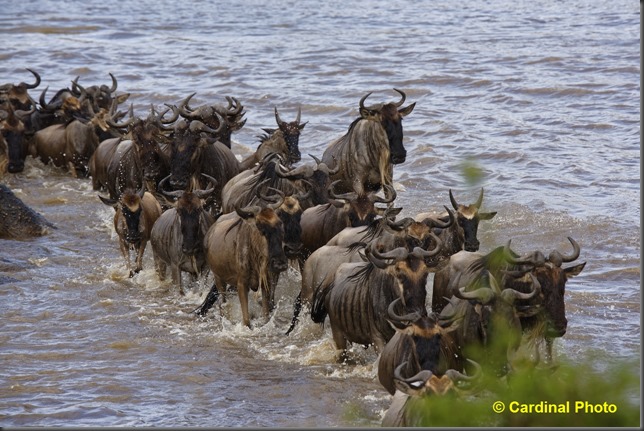
Nikon D810, Sigma 120-300mm f/2.8 Lens w. 1.4x TC @ 420mm. f/8 @ 1/1000s, ISO 800
Image processed with DxO Optics Pro
Also unlike most migrations, the Wildebeest are often in no hurry to move from one side of the river to the other. They often gather on the bank in large groups, perhaps with a few individuals testing out the water’s edge, only to move away and go back to grazing. So you can’t just show up at one of the crossing areas along the River (of which there are at least a dozen) and expect action. It is best to set aside some time to watch and wait. It is actually almost as much fun to sit perched on a hill above the river and watch the groups of animals form and reform as it is to watch them cross. We spent most of the day above the river one day, complete with a nice picnic lunch. Our patience was rewarded with two crossings that day – although neither occurred until after 3pm – so it was great that we had the time to wait them out.
Crocs are over-rated
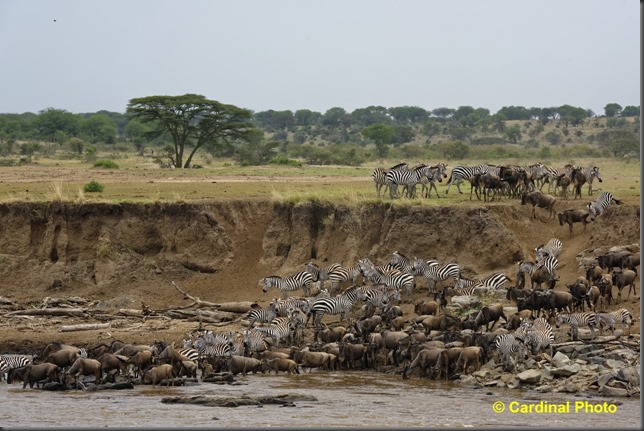
Nikon D810, Sigma 120-300mm f/2.8 Lens @ 195mm. f/9.5 @ 1/1500s, ISO 800
Image processed with DxO Optics Pro
Crocodiles don’t need to eat very often, so after the beginning of the migration, where they make up for some lean months, most crocs aren’t really that aggressive about going after the crossing animals. Of course, when they do it is exciting to watch, and we certainly saw a couple Wildebeest calves grabbed by crocs in one of the crossings we witnessed, but in others every animal made it safely across.

